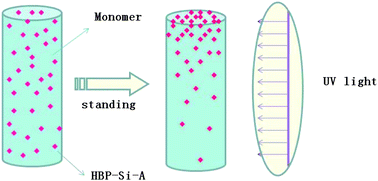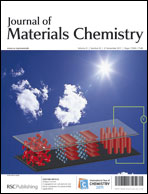This paper reported a polysiloxane benzophenone photoinitiator (HBP-Si-A), which was synthesized based on traditional photoinitiator 4-Hydroxybenzophenone (HBP) and epoxy polysiloxane. Its structure was confirmed by proton nuclear magnetic resonance (1H-NMR), fourier transform infrared spectroscopy (FT-IR) and gel permeation chromatography (GPC). The kinetics of photopolymerization initiated by HBP-Si-A was studied by real-time infrared spectroscopy (RTIR). More importantly, it is proved by X-ray photoelectron spectroscopy (XPS), UV absorption and GPC measurements that the polysiloxane benzophenone photoinitiator (HBP-Si-A) had good ability to float up. As a result, the HBP-Si-A could easily form concentration gradient in photopolymerization system and initiate gradient photopolymerization. A convenient and simple method for preparing gradient polymer initiated by HBP-Si-A was successfully developed. The surface morphology and elemental composition of each segment of poly(tripropylene glycol diacrylate) (PTPGDA) were studied by scanning electron microscopy (SEM) and energy dispersive spectrometer (EDS) respectively. In addition, HBP-Si-A could also more effectively mitigate inhibition of oxygen in radical photopolymerization.

You have access to this article
 Please wait while we load your content...
Something went wrong. Try again?
Please wait while we load your content...
Something went wrong. Try again?


 Please wait while we load your content...
Please wait while we load your content...